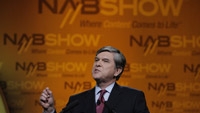NAB in ‘full battle mode’ to protect against involuntary spectrum seizures, says Smith

The NAB is in “full battle mode” to protect television licensees from being forced by the federal government to relinquish spectrum involuntarily, Gordon Smith, president and CEO of the broadcast trade association, said during his 2011 NAB Show keynote Tuesday, April 12.
The head of the NAB delivered his thoughts to a convention audience largely composed of attendees who less than an hour before heard FCC Chairman Julius Genachowski admonish broadcasters that “voluntary incentive auctions” should not be construed to mean TV broadcasters are being granted “veto power over the success of the auction” by having “a new and unprecedented right to keep their exact channel.”
Genachowski’s comments relate to the FCC’s National Broadband Plan, which aims to reclaim 120MHz of spectrum currently used for over-the-air broadcasting. Under the plan, stations wishing to voluntarily give up some or all of their spectrum would share in the proceeds of an auction of that spectrum to wireless providers. Another essential component is to repack the remaining TV broadcasters in what’s left of the television band to create wide contiguous swaths of vacant spectrum for wireless operators.
“It concerns us that the FCC could forcibly relocate a broadcaster, crowd channels closer together, reduce their coverage, destroy innovation for viewers, increase interference, or otherwise degrade their signal,” Smith said during his keynote.
In his keynote, Smith reminded those in attendance that less than two years ago television broadcasters gave back to the government more than 25 percent of TV spectrum and completed the analog-to-digital television transition, which cost $15 billion.
“Now, less than two years later, wireless companies want another 40 percent of TV spectrum. Hey, we already gave at the office,” he said.
An important aspect of the unfolding debate about how best to use spectrum revolves around what constitutes efficient use of spectrum. The FCC and members of the wireless industry contend TV broadcasters are inefficient spectrum users because wide portions of spectrum between channels go unused to protect against harmful interference. Broadcast interests counter that their one-to-many transmission architecture makes them highly efficient spectrum users.
The professional video industry's #1 source for news, trends and product and tech information. Sign up below.
Smith echoed those sentiments in his keynote. Saying there isn’t “enough spectrum in the universe to replace our one-to-many broadcast system” with a one-to-one transmission architecture used for cell phone service, Smith said wireless operators see value in a broadcast architecture. “Even the wireless companies themselves concede they will need to eventually use some of their spectrum in a broadcast-type architecture, specifically for sending mass appeal video content to smartphones,” he said.
“Broadcasting already has the architecture, and it's worked for more than 60 years. What sense does it make to take spectrum that is being used efficiently and use it less efficiently?” he asked.
Smith told his audience that the source of the spectrum crunch for wireless services is the wireless industry itself. “The fact is there has been more spectrum allocated to mobile broadband than there is capital to deploy it,” he said.
“What is needed to address the capacity crunch is more investment in towers and infrastructure, and receiver standards that maximize the use of the huge swaths of spectrum that wireless carriers have already been allocated,” said Smith.
Smith called for a “respected third party,” such as the Government Accounting Office, to conduct “a comprehensive inventory of what spectrum is out there and more importantly, how much of and how it is being used today” to ensure the nation finds the best way to meet its communications and spectrum needs.
“There's a lot at stake here. So why rush? Once spectrum is reallocated and local TV stations are gone, they won't be coming back. And at what cost to the 43 million people that rely exclusively on over-the-air television for free?” he asked.
Phil Kurz is a contributing editor to TV Tech. He has written about TV and video technology for more than 30 years and served as editor of three leading industry magazines. He earned a Bachelor of Journalism and a Master’s Degree in Journalism from the University of Missouri-Columbia School of Journalism.

